In the history of our hobby, there have been loads of legendary side-scrolling beat ’em ups, offering players the chance to team up and punch a bunch of fools in a quest to save a city, a girl, a president, or some combination of those things. If there’s one name that stands above the rest in the hearts and minds of players, however, it’s got to be Teenage Mutant Ninja Turtles. Now, it isn’t that any of Konami’s TMNT games were necessarily the best of the best of the genre, but they almost always had a great balance of fun characters, exciting stages, and satisfying difficulty levels.
As we’ve seen names such as Double Dragon, Kunio-kun, and Streets of Rage make modernized returns in recent years, the idea wasn’t so much if we’d get a new TMNT beat ‘em up, but when we’d get one—and how much it’d cost for the license.
Even as only a casual fan of the universe that oozed out from the minds of Kevin Eastman and Peter Laird, I’d still found myself getting really excited for the release of Teenage Mutant Ninja Turtles: Shredder’s Revenge. From everything we’d seen up until this point, it looked as if the game would have stunning graphics, great gameplay, and a rockin’ soundtrack.
Well, as another classic pop cultural icon, Meat Loaf, once sang: Now don’t be sad, ’cause two out of three ain’t bad.

There really is nowhere else I can start when talking about Shredder’s Revenge other than its visuals, because they’re the first thing you’ll notice and are by far the game’s best feature. Based upon the work of amazing pixel artist Paul Robertson, every character in the game—from the teen turtles themselves, to their allies, to the Foot soldiers and various other baddies—come to life in a way that is just a joy to witness. Everyone looks colorful and cartoony but never silly, each of the turtles (not to mention the rest of the cast) have their own unique animations. There’s an artistic consistency to everything that can actually be hard for sprite-based games to achieve.
As well, the various stages do a great job of showcasing just how gorgeous of a game this is. While I don’t think they’re quite on the level of what we saw in Scott Pilgrim vs. The World: The Game (which key members of Tribute Games worked on before leaving Ubisoft) in terms of little details, they still stand as fantastic examples of just how good 2D games can look. Even though the adventure (mostly) takes place across Manhattan, there’s a nice amount of variety in the locations you’ll be visiting, keeping things feeling fresh for most of the way through.
That variety is also seen in the gameplay of Shredder’s Revenge, which finds a satisfying balance between offering depth without being too overwhelming. Just for a little context, I booted up Teenage Mutant Ninja Turtles: The Hyperstone Heist on Genesis while working on this review, and very quickly realized how repetitive those older games in the franchise can now feel. Here, you’ve got standard combos, a variety of throws and jump attacks, rolls (which can combo into attacks), and a number of different super abilities you can unleash if you’ve got enough Ninja Power. While all of the selectable characters—Leonardo, Donatello, Raphael, Michelangelo, Splinter, April O’Neil, and the unlockable Casey Jones—all play the same in theory, each feels different not only in their stats, but also in variables such as timing, reach, or those super abilities. There really isn’t a bad character of the bunch, so even if you’ve got a full team of six players all jumping into the game, you won’t have to feel like you’re getting stuck with a garbage pick.

Of course, none of that means much if there isn’t a roster of enemies to provide both variety and challenge, and Shredder’s Revenge is also pretty solid in that regard. Early on, I was feeling like the game was a little too easy, but some of the later enemies are serious pricks. The dev team never relied on any of the presented enemy types too often, meaning every stage introduces a new style of threat or mixes things up in some other way. The only real complaint I have in this area is that the bosses are slightly disappointing in terms of complexity and difficulty. Maybe playing so much Elden Ring in recent months has me in the mindset that every boss should fight like it’s an end boss, but I think the selection we get here tends to lean too far toward quantity and not enough toward quality.
So, given I’m smitten with Teenage Mutant Ninja Turtles: Shredder’s Revenge’s visuals, and have mostly good things to say about its gameplay, that means my disappointment must lie in its final area: audio.
I’m not hot on the game’s soundtrack. Now, as someone who loved the work of Tee Lopes in Sonic Mania, I feel a little surprised to say that. However, the problem with Shredder’s Revenge goes deeper than just its music. All of the audio in this game is disappointing, to a degree that’s a little baffling. Some of the voice acting sounds really off. Attacks often lack that satisfying oomph when hitting an opponent. Explosions sound anemic. A few of the sound effects are just outright terrible. Sometimes, you’d think a certain action or object should have an audio cue associated with it, and there’s nothing. While the audio in Shredder’s Revenge is by far its weakest element, it’s also the game’s least important element if we’re being honest. (Back in the arcades, we could never even hear the audio anyhow.) Still—and I’m perfectly willing to recognize that many of you might disagree with me on all of this—I’m disappointed with what the game has to offer our ears.
Part of the problem, I think, is that Shredder’s Revenge suffers the same fate that many Sega CD and Turbo-CD games did. Back when the CD was first introduced as a storage medium for video games, you’d have releases that would combine 16-bit visuals with far superior audio. Sometimes, that would result in a Dracula-X, or an Ys Book I & II, or a Lord of Thunder, where the three core pillars of the game gelled together wonderfully. Far more often, unfortunately, you’d have games that looked and played decidedly 16-bit, with music that sounded like it belonged to some completely different game. Given how much work has gone into making its overall style look and feel retro, the audio in Shredder’s Revenge is too modern on a technical level—and in certain cases, even directly clashes with what we’re seeing and playing. I’d love to see Tribute Games release a free (or even paid) DLC which gives us music and sound effects crafted to evoke that similar retro nostalgia as an option.
And, when they’re giving us that patch, the team could also fix the game’s misguided Arcade mode.

TMNT: Shredder’s Revenge offers two main modes of play: Story, and Arcade. In Story, you travel across an overworld map from one narrative beat to the next. Each point you open up is a new stage, and when not progressing the story, you can travel back to previous stages in order to complete a handful of side missions. The Story mode is playable solo or with up to five other people either locally or online, you can individually level characters to unlock new skills, and you can save and quit whenever you’d like. When playing Shredder’s Revenge for the purposes of this review, my first focus was on Story mode, and I came away from it with very positive opinions on the game.
Arcade is the other mode we’re presented here, and I simply do not understand what Tribute Games was thinking there. When you give me a beat ’em up with an “arcade” mode, I expect a fun yet not incredibly deep experience, where I’ll probably play six to eight stages, taking maybe 30 to 40 minutes to complete. Instead, this Arcade mode takes us through the entirety of Story mode’s 16 stages (which average between 5 to 10 minutes to complete), one after the other, without the option to save or even the ability to select a new character after you die when playing solo. Sixteen stages, taking just under two hours to beat, is not an arcade mode.
I completely understand the developers wanting to make a big, beefy experience that would both satisfy players and stand as a memorable new entry in the series, but you can’t just line up all of those stages in a row and call it an “arcade” mode. How many people are going to want to sit down with friends and family and spend that much time to get through the game in one go? I feel very confident that most people will play a handful of stages, and then just quit, never seeing a decent chunk of what awaits later in the game.

The good news is, there’s a relatively easy fix to this, one that Tribute Games can still implement after the fact. Countless other beat ’em ups over the years have featured branching paths, and that’s all we need here. Use that large amount of stages to provide numerous ways to get to the end, resulting in a shorter, tighter game that then offers much more variety every time you play. While the stages presented in Shredder’s Revenge weren’t crafted specifically with the idea of branching paths in mind, they also aren’t that reliant on you going through every one of them. In fact, there’s even a three-stage chunk of the Story mode that could easily split off into its own path. Given that section of the game, some of the deeper cuts the dev team made for bosses, and a few other specific elements found throughout the game, I do actually wonder if the idea of branching paths in the Arcade mode existed at one point before getting scrapped.
Teenage Mutant Ninja Turtles: Shredder’s Revenge is not the game I was hoping it would be—but transforming it into that game would entirely be possible without any huge reworkings to what Tribute Games has given us. However, what they have given us is what matters at the end of the day, and even with my misgivings, there’s still a pretty darn good game here. The Arcade mode’s length could absolutely be a deal breaker for some, but if it isn’t for you, then there’s an enjoyable, beautiful new beat ‘em up experience waiting for you here. Dig deep into the Story mode, marathon the Arcade mode now and then when you’re up for the challenge, and enjoy the care and attention that went into giving the heroes in a half shell a worthy new adventure, pimples and all.
It’s like getting a hot, cheezy, crisp-crusted pizza delivered to your door—and then realizing someone ordered it with pineapple and black olives as two of the toppings.
|
★★★★☆
Teenage Mutant Ninja Turtles: Shredder’s Revenge looks to bring back the glory days of Konami’s side-scrolling arcade beat ’em ups and home hits based on everyone’s favorite young green ninjas. In its visuals and gameplay, Dotemu and Tribute Games have not only matched those retro classics that they’re paying homage to here, but perhaps even surpassed them. Sadly, this trip through time is somewhat marred by inconsistent audio and an Arcade mode that feels more like a slog than a thrill. |
Developer Tribute Games Publisher Dotemu ESRB E10+ Release Date 06.16.2022 |
| Teenage Mutant Ninja Turtles: Shredder's Revenge is available on Switch, Xbox One, PS4, PC. Primary version played was for Nintendo Switch. Product was provided by Dotemu for the benefit of this coverage. EGM reviews on a scale of one to five stars. | |

Mollie got her start in games media via the crazy world of gaming fanzines, and now works at EGM with the goal of covering all of the weird Japanese and niche releases that nobody else on staff cares about. She’s active in the gaming community on a personal level, and an outspoken voice on topics such as equality in gaming, consumer rights, and good UI. Check her out on Bluesky and Mastodon.